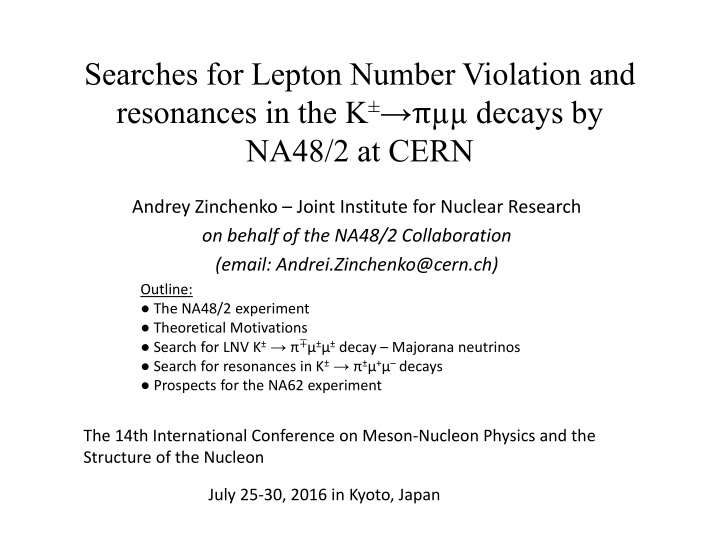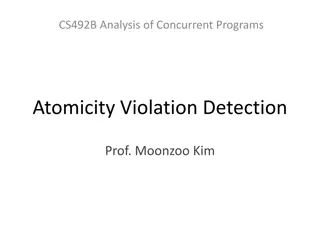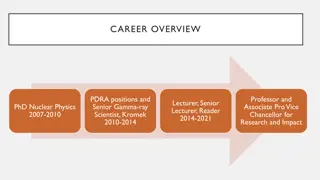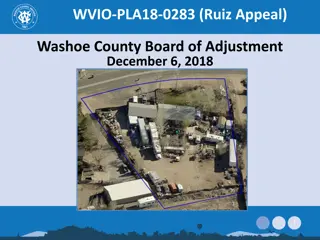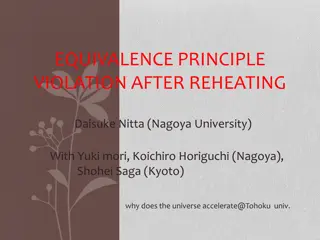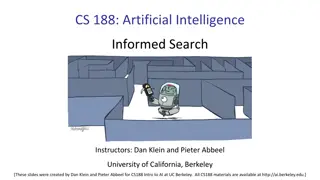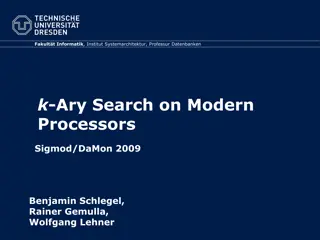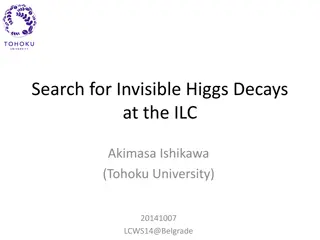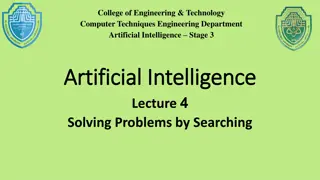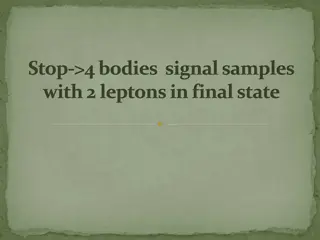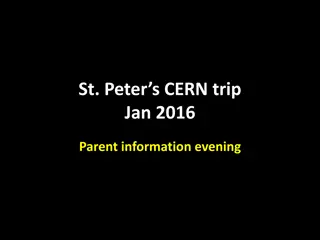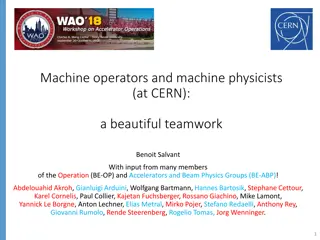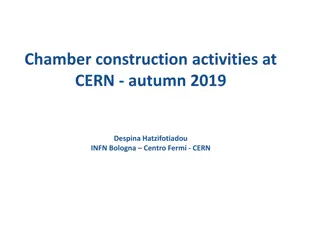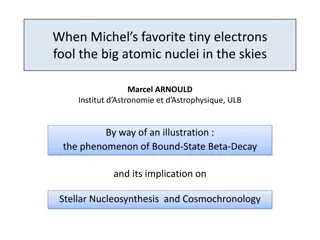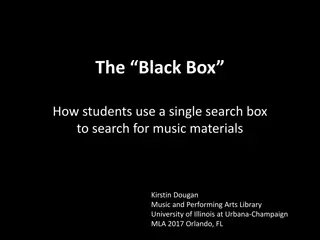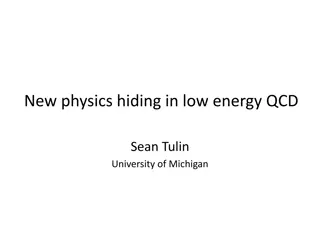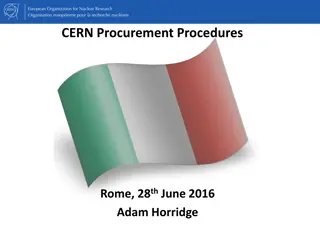Search for Lepton Number Violation in K Decays at CERN
Investigation of Lepton Number Violation and resonances in K decays using the NA48/2 experiment at CERN. Theoretical motivations include Majorana neutrinos and search for resonances in K+ decays. Detailed outline of the experiment, detector specifications, and potential implications discussed.
Download Presentation

Please find below an Image/Link to download the presentation.
The content on the website is provided AS IS for your information and personal use only. It may not be sold, licensed, or shared on other websites without obtaining consent from the author.If you encounter any issues during the download, it is possible that the publisher has removed the file from their server.
You are allowed to download the files provided on this website for personal or commercial use, subject to the condition that they are used lawfully. All files are the property of their respective owners.
The content on the website is provided AS IS for your information and personal use only. It may not be sold, licensed, or shared on other websites without obtaining consent from the author.
E N D
Presentation Transcript
Searches for Lepton Number Violation and resonances in the K decays by NA48/2 at CERN Andrey Zinchenko Joint Institute for Nuclear Research on behalf of the NA48/2 Collaboration (email: Andrei.Zinchenko@cern.ch) Outline: The NA48/2 experiment Theoretical Motivations Search for LNV K decay Majorana neutrinos Search for resonances in K + decays Prospects for the NA62 experiment The 14th International Conference on Meson-Nucleon Physics and the Structure of the Nucleon July 25-30, 2016 in Kyoto, Japan
Introduction The NA48/2 experiment The NA48/2 detector Narrow momentum band K beams: PK= 60 GeV/c, PK/PK 4% (rms) Nominal K decay rate: 100 kHz Main triggers: 3-track vertex K + - Simultaneous K+/K beams Principal sub-detectors: Spectrometer (4 DCHs) p/p = 1.02% 0.044% p(GeV/c) 4 views/DCH: redundancy efficiency Scintillator Hodoscope Fast trigger, time measurement t 150 ps LKr EM calorimeter High-granularity, quasi-homogeneous E/E = 3.2%/ E(GeV) 9%/E(GeV) 0.42% x= y= 4.2mm/ E(GeV) 0.6mm (1.5mm @ 10 GeV) MUV: consisted of three 2:7 x 2:7 m2planes of plastic scintillator strips, each preceded by a 80 cm thick iron wall. 26/07/2016 Andrey Zinchenko MENU 2016 Kyoto
Theoretical Motivations Majorana Neutrinos AsakaShaposhnikov model ( MSM) [Asaka and Shaposhnikov, PLB 620 (2005) 17]: Dark Matter + Baryon Asymmetry of the Universe (BAU) + low mass of SM can be explained by adding three sterile Majorana neutrinos Nito the SM N1 is the lightest O(keV) Dark Matter candidate N2, N3 are nearly degenerate (100 MeV to few GeV) to tune CPV-phases and extra-CKM sources of baryon asymmetry. N2, N3 produce standard neutrino masses through seesaw with a Yukawa coupling of ~ 10-8 Activesterile neutrino mixing (U-matrix): Effective vertices involving the sterile neutrinos Ni, the W , Z bosons and SM leptons BR(K N4) x BR(N4 ) ~ |U 4|4 Inflatons Shaposhnikov-Tkachev model [Shaposhnikov and Tkachev, PLB 639 (2006) 414]: MSM + a real scalar field (inflaton ) with scale-invariant couplings Explains Universe homogeneity and isotropy on large scales/structures on smaller scales -Higgs mixing with mixing angle -Higgs coupling Universe reheating -is unstable: ~ (10-8-10-12) s in Kaon decays [m < 354 MeV/c2] 26/07/2016 Andrey Zinchenko MENU 2016 Kyoto
Search for resonances in K decays Same-sign muons sample The NA48/2 same-sign muons sample (LNV) Basic principles of the searches: Fully reconstructed final states, 3-track vertex topology Similar topology to normalisation channel K + First-order cancellation of systematic effects (trigger inefficiency, etc) Method: exclusive search for the K decay Main background: K + -with 2 decays (one within the Spectrometer) Sensitivity: UL on BR(K ) UL on BR(K N4)xBR(N4 ) K decays in the fiducial volume: NK 2x1011 (from reconstructed K + decays) Mass and lifetime dependence of the signal acceptance from dedicated MC simulation of the signal 26/07/2016 Andrey Zinchenko MENU 2016 Kyoto
Search for resonances in K decays Same-sign muons sample The same-sign muons selection (LNV) Blind analysis: K selection based on o K MC simulation Uniform phasespace (|Mfi|2 = 1) Resonant Majorana neutrino model o K + -MC simulation (1010events) o Control Region: M( ) < 480 MeV/c2 Event selection: o One wellreconstructed 3-track vertex o 2 same-sign muons, 1 odd-sign pion o Total PTconsistent with zero o Signal Region: |M( ) MK| < 5 MeV/c2 Expected background: Additional K + MC sample (1010events) used to evaluate number of expected K + events in Signal Region Events in Signal Region observed after finalising K selection Nobs= 1 Expected background (from MC simulation): Nexp=1.163 0.867stat 0.021ext 0.116syst BR(K ) < 8.6 x 10-11@ 90% CL Rolke-Lopez statistical treatment to get UL( UL(N sig ) 26/07/2016 N ) sig Andrey Zinchenko MENU 2016 Kyoto
Search for resonances in K decays Opposite-sign muons sample The NA48/2 opposite-sign muons sample (LNC) Basic principles of the searches: Fully reconstructed final states, 3-track vertex topology Similar topology to normalisation channel K + Firstorder cancellation of systematic effects (trigger inefficiency, etc) Search for resonances in K + decays Method: exclusive search for the decay chains K N4(N4 ), K X(X + ) Main background: K + (irreducible) Limited sensitivity Sensitivity: UL on BR(K N4) x BR(N4 ) UL on BR(K X) x BR(X + ) Andrey Zinchenko MENU 2016 Kyoto 26/07/2016
Search for resonances in K decays Opposite-sign muons sample The opposite sign muons selection (LNC) Event selection: o Minimal changes with respect to same-sign o One well-reconstructed 3-track vertex o 2 opposite-sign muons, 1 pion o Total PTconsistent with zero o Signal Region: |M( + ) MK| < 8 MeV/c2 To be scanned searching for peaks in M( ) and M( + ) invariant masses 3489 K + candidates in Signal Region K + background: (0.36 0.10)% Improved selection with respect to previous NA48/2 K + analysis [PLB 697 (2011) 107] 26/07/2016 Andrey Zinchenko MENU 2016 Kyoto
Search for resonances in K decays Mass scan framework The mass scan framework Basic principles: Based on selected K candidates. Variable step = 0.5 (Mres) and window = 2 (Mres) For each Mres: Observed events in data (Nobs) vs Expected events from MC (Nexp) UL(Nsig) Rolke-Lopez statistical treatment used in each mass hypothesis Mresto get UL(Nsig) Search for Lepton Number Violation Majorana neutrinos 284 mass hypotheses Mrestested 2 possibilities in building M( ) [same-sign s]: closest invariant mass to Mresconsidered Search for resonances in K + decays The distributions of both invariant masses M( ) and M( + ) are probed 267 hypotheses for M( ) 280 hypotheses for M( + ) K + MC simulation uses form factors extracted from the selected data sample to obtain best data/MC agreement 26/07/2016 Andrey Zinchenko MENU 2016 Kyoto
Search for resonances in K decays Final results Search for K N4(N4 ) decays Same-sign muons sample (LNV) UL(BR(K N4)BR(N4 ))= Statistical significance never exceeds +3 : no signal observed 26/07/2016 Andrey Zinchenko MENU 2016 Kyoto
Search for resonances in K decays Final results Search for K N4(N4 ) decays UL(BR(K N4)BR(N4 ))= Statistical significance never exceeds +3 : no signal observed 26/07/2016 Andrey Zinchenko MENU 2016 Kyoto
Search for resonances in K decays Final results Search for K X(X + ) decays UL(BR(K X)BR(X + ))= Oppositesign muons sample (LNC) Statistical significance never exceeds +3 : no signal observed 26/07/2016 Andrey Zinchenko MENU 2016 Kyoto
The NA62 experiment Prospects Prospects for the new NA62 experiment NA62 will collect the world-largest K+ decay sample: ~ 1013decays in 3 years of data taking (~ 50 times more than NA48/2) Kaon and 0LNFV decays Mode UL at 90% CL Experiment NA62 acceptance* * From fast MC with flat phase-space distribution. K+ + +e 1.3 10 11 BNL 777/865 ~ 10% Single-event sensitivity: K+ + e+ 5.2 10-10 BNL 865 ~ 10% K+ +e+ 5.0 10-10 BNL 865 ~ 10% K+ e+e+ K+ + + 6.4 10-10 BNL 865 ~ 5% 8.6 10-11 NA48/2 ~ 20% K+ e+e+ K+ e + + 2.0 10-8 Geneva Saclay ~ 2% no data ~ 10% NA62 Sensitivities: ~10 12 for K+decays ~10 11 for 0decays 0 +e 0 e+ 3.6 10-6 KTeV ~2% 26/07/2016 Andrey Zinchenko MENU 2016 Kyoto
Conclusions Conclusions The NA48/2 experiment at CERN was exposed to 2x1011K decays in 2003-2004 New NA48/2 results presented for the first time today: Search for LNV K decay: BR(K ) < 8.6 x 10-11@ 90% CL [World Best Limit] Factor of 10 improvement with respect to previous best limit [1.1 x 10-9@ 90% CL] Search for K N4(N4 ) decays [Majorana neutrinos] Limits on BR products of the order of 10-10for neutrino lifetimes < 100 ps Search for K N4(N4 ) decays [LNC heavy neutrinos] Limits on BR products of the order of 10-9for neutrino lifetimes < 100 ps Search for K X(X + ) decays [Inflatons, ] Limits on BR products of the order of 10-9for resonance lifetimes < 100 ps Prospects for the new NA62 experiment: Major beam and detector upgrades for K+ + : improved performances NA62 will collect the world-largest K+decay sample ( 1013) in 3 years of data taking Potential sensitivities ~ 10-12for K decays, ~ 10-11for 0decays 26/07/2016 Andrey Zinchenko MENU 2016 Kyoto
